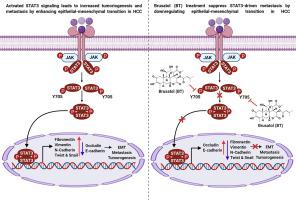Journal of Advanced Research ( IF 10.7 ) Pub Date : 2020-07-13 , DOI: 10.1016/j.jare.2020.07.004 Jong Hyun Lee 1 , Chakrabhavi Dhananjaya Mohan 2 , Amudha Deivasigamani 3 , Young Yun Jung 1 , Shobith Rangappa 4 , Salundi Basappa 5 , Arunachalam Chinnathambi 6 , Tahani Awad Alahmadi 7 , Sulaiman Ali Alharbi 6 , Manoj Garg 8 , Zhi-Xiu Lin 9 , Kanchugarakoppal S Rangappa 10 , Gautam Sethi 11 , Kam Man Hui 3, 12, 13, 14, 15 , Kwang Seok Ahn 1

|
Introduction
Epithelial-mesenchymal transition (EMT) is a process of transdifferentiation where epithelial cells attain mesenchymal phenotype to gain invasive properties and thus, can contribute to metastasis of tumor cells.
Objectives
The antimetastatic and antitumor efficacy of brusatol (BT) was investigated in a hepatocellular carcinoma (HCC) model.
Methods
We evaluated the action of BT on EMT process using various biological assays in HCC cell lines and its effect on tumorigenesis in an orthotopic mouse model.
Results
We found that BT treatment restored the expression of Occludin, E-cadherin (epithelial markers) while suppressing the levels of different mesenchymal markers in HCC cells and tumor tissues. Moreover, we observed a decline in the expression of transcription factors (Snail, Twist). Since the expression of these two factors can be regulated by STAT3 signaling, we deciphered the influence of BT on modulation of this pathway. BT suppressed the phosphorylation of STAT3Y705 and STAT3 depletion using siRNA resulted in the restoration of epithelial markers. Importantly, BT (1mg/kg) reduced the tumor burden in orthotopic mouse model with a concurrent decline in lung metastasis.
Conclusions
Overall, our results demonstrate that BT interferes with STAT3 induced metastasis by altering the expression of EMT-related proteins in HCC model.
中文翻译:

Brusatol通过下调肝细胞癌上皮-间质转化抑制STAT3驱动的转移
介绍
上皮-间质转化 (EMT) 是一个转分化过程,其中上皮细胞获得间充质表型以获得侵袭性,从而有助于肿瘤细胞的转移。
目标
在肝细胞癌 (HCC) 模型中研究了 brusatol (BT) 的抗转移和抗肿瘤功效。
方法
我们使用 HCC 细胞系中的各种生物测定法评估了 BT 对 EMT 过程的作用及其对原位小鼠模型中肿瘤发生的影响。
结果
我们发现 BT 治疗恢复了 Occludin、E-cadherin(上皮标志物)的表达,同时抑制了 HCC 细胞和肿瘤组织中不同间充质标志物的水平。此外,我们观察到转录因子(Snail,Twist)的表达下降。由于这两个因子的表达可以通过 STAT3 信号传导来调节,我们破译了 BT 对该通路调节的影响。BT 抑制了 STAT3 Y705的磷酸化,并且使用 siRNA 的 STAT3 消耗导致上皮标志物的恢复。重要的是,BT (1mg/kg) 降低了原位小鼠模型中的肿瘤负荷,同时肺转移减少。
结论
总体而言,我们的结果表明,BT 通过改变 HCC 模型中 EMT 相关蛋白的表达来干扰 STAT3 诱导的转移。



























 京公网安备 11010802027423号
京公网安备 11010802027423号